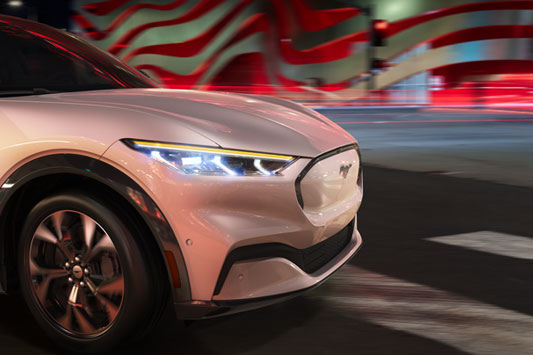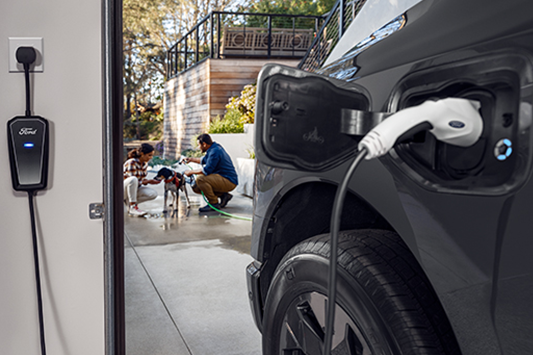Leif Johnson Ford EV FAQ
What kind of electric vehicles are there?
- Hybrid – Hybrid vehicles are usually powered by both gas and electric motor, offering greatly improved fuel efficiency and low emissions at an affordable price. Equipped with regenerative braking systems, hybrid vehicles recapture energy during braking to recharge the battery for the electric motor. Hybrid vehicles are excellent choices for people looking for the benefits of an electric vehicle without having to worry about EV charging infrastructure and higher prices of EVs.
- Plug-in Hybrid – Plug-in Hybrid vehicles are basically half hybrid and half EV. While still powered by a gas and electric motor, the plug-in hybrid gets longer range on its battery before switching to the “hybrid” gas-electric motors and needs to be plugged in to be recharged.
- Fully Electric – Fully electric vehicles are completely powered by batteries and an electric motor with driving ranges from 200-300+ miles on a single charge depending on the vehicle and its battery/engine configuration. Electric vehicles also usually offer enhanced performance capabilities due to the instant torque available when you step on the accelerator pedal. Since EVs don’t use gas they can only be recharged at home and designated recharging stations, so be sure to plan accordingly when going on long distance trips.
How do you recharge an electric vehicle?
- Home chargers – Owners of EVs can buy an at-home Ford Connected Charge Station with 48 amps that will let you charge up your vehicle as quickly as possible.
- Ford Mobile Charger – Using the Ford Mobile Charger, EV owners can charge their vehicle with a regular 120-volt or 240-volt power outlet. It is important to note that charging your EV with a normal power outlet will not be as fast as the Ford Charge Station or designated charging station.
- Charging stations – Out on the road and need to recharge quickly? Locate a charging station near you to take advantage of optimized charging times so you can get back on the road fast.
How far can you drive on a single charge?
It depends on the vehicle, the size of the battery and configuration of electric motors. The Mustang Mach-E, F-150 Lightning and E-Transit have an estimated range of 224 miles with a standard battery and up to 312 miles with the extended range battery.
How long does it take to charge an EV vehicle?
Most electric vehicles will take between 12-18 hours to fully charge on a level 2 charger (enhanced EV home charger). On a level 1 charger (home power outlet) can take 24+ hours to fully charge. And a level 3 (fast charging station) charger can recharge your battery up to 80% in as little as 30 minutes.
What are the benefits of buying an electric vehicle?
- Don’t need to pay for expensive gas prices – With a fully electric vehicle you’ll no longer have to deal with expensive gas prices. While charging electric vehicles still has its costs, you can expect to save almost $1,000 in fuel costs per year when driving an EV.
- Performance – One of the benefits of fully electric motors is that they provide instant torque response which gives you increased acceleration and a much more exhilarating driving experience. Most EV models offer lower powered electric motors that still offer good performance while not being too much for most drivers. Upgrade to a higher powered electric motor like in the Mustang Mach-E and experience truly breathtaking performance with a 0-60 of just 3.5 seconds!
- No emissions – Another benefit of driving an electric vehicle is that they are zero emissions. For those who are concerned about driving as green as possible, EVs remain the best choice.
- EV tax credits – When purchasing select EVs, buyers can earn up to a $7,500 tax incentive to help offset the cost of purchasing an EV.
How is the recharging infrastructure for electric vehicles?
Currently throughout the entire United States there are more than 56,000 EV charging stations with another 148,000 charging ports and there are plans to build much more EV charging infrastructure in the future. In the state of Texas there are over 2,000 charging stations with more planned as well. In Austin alone there are over 640 charging stations. With the infrastructure as it currently is and with more charging stations planned over the next 10 years, it should get easier and easier to find a place to charge up almost anywhere in the country.
However, it still remains important to carefully plan out any sort of long/extended trips you may take in your EV so you can locate a charging station in time before your battery runs out.
How long do electric batteries last?
It is currently estimated that EV batteries can last between 100,000-200,000 miles or 10-20 years depending on factors like weather conditions (extreme heat or cold), driving style, and charging habits. Ford also offers an 8-year/100,000 mile battery warranty to help protect you should any serious issues occur during that period. To help keep your battery in the best condition for longer, charge your EV mainly at home and keep the battery between 20%-90% and charge to 100% for only long road trips. This will help lengthen your battery’s life.

NEW FORD EV
View Inventory